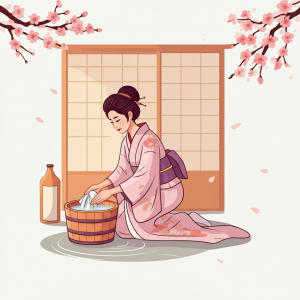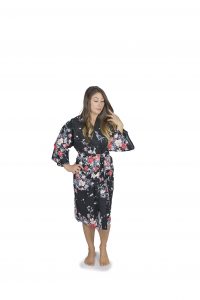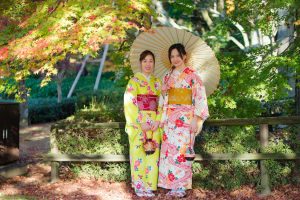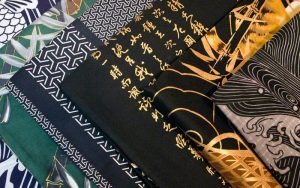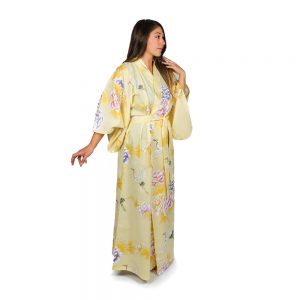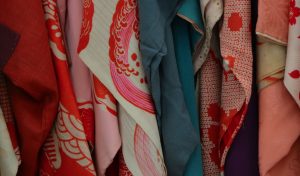Your kimono or yukata robe is more than just clothing; it’s a piece of wearable art steeped in tradition and comfort. Whether you wear it for lounging, special occasions, or as a connection to Japanese culture, you want to keep it looking its best. Proper care is essential for preserving the vibrant colors and soft feel of the 100% cotton fabric. This guide will walk you through the simple steps to wash and dry your robe, ensuring it remains beautiful for years to come.
We will cover the best practices for washing, the benefits of using cold water, and the ideal methods for drying your garments. With a little attention, you can easily maintain the quality and longevity of your cherished robe.
The Gentle Art of Washing Your Robe
Washing your kimono or yukata doesn’t have to be complicated. The key is to be gentle. Harsh washing cycles, hot water, and strong detergents can damage the delicate cotton fibers, leading to fading and wear. Following a few simple rules will protect your investment and keep your robe in pristine condition.
Why Cold Water is Your Best Friend
Choosing the right water temperature is the single most important step in washing your robe. Always opt for a cold water wash. This simple choice offers significant benefits for the fabric and its appearance.
Hot water can be aggressive on fabrics, especially natural ones like 100% cotton. It causes fibers to constrict and can lead to shrinkage and stress on the seams. Cold water, on the other hand, cleans effectively without being harsh, gently lifting away dirt and oils. This gentle approach helps extend the overall lifespan of your garment.
Furthermore, cold water is crucial for color preservation. The rich patterns and deep dyes that make your kimono or yukata so striking are vulnerable to heat. Hot water can cause these colors to bleed and fade over time, leaving your robe looking dull. A cold wash helps lock in the dyes, keeping the colors as vivid and bright as the day you got it.
Choosing the Right Settings and Detergent
Once you’ve committed to cold water, select the proper settings on your washing machine.
- Use the Delicate or Gentle Cycle: This setting mimics hand washing by using a slower spin and less agitation, which prevents stretching and damage.
- Wash with Similar Colors: To prevent any potential color transfer, wash your robe with other dark or similarly colored items. For the first wash, it’s a good idea to wash it alone.
- Use a Mild Detergent: Choose a gentle, pH-neutral detergent. Avoid harsh chemicals, bleach, and fabric softeners, as they can break down cotton fibers and leave a residue that dulls the fabric’s feel and appearance.
Perfecting the Drying Process
How you dry your kimono or yukata is just as important as how you wash it. High heat is the enemy of cotton, leading to shrinkage and irreversible damage to the fibers. The goal is to dry your robe gently, preserving its shape and softness.
The Tumble Dry and Hang Dry Method
For the best results, we recommend a two-step drying process. This combination method quickly removes most of the moisture without exposing the fabric to prolonged, damaging heat.
First, place your robe in the dryer on a low heat or no heat (air fluff) setting. Let it tumble for a short period, around 10 to 15 minutes. The purpose of this step is not to dry the garment completely but to remove excess water and fluff the fibers, which helps prevent stiffness. A short, low-heat tumble is all that’s needed.
Finishing with a Drip Dry
After the brief tumble dry, remove the robe while it is still damp. The final and most crucial step is to hang it up to air dry.
Find a spot with good air circulation, away from direct sunlight, which can cause colors to fade. A sturdy, kimono hanger is ideal to support the garment’s weight and help it maintain its shape, especially around the shoulders. Smooth out any wrinkles with your hands before hanging. Allowing your robe to drip dry for the remainder of the time is the gentlest way to finish the process. It prevents shrinkage and ensures the cotton fabric stays soft and comfortable against your skin.
Caring for Your Robe, Preserving a Tradition
Your kimono or yukata robe is a special garment that brings comfort and elegance into your life. By following these simple care instructions—washing in cold water on a gentle cycle and using a combination of low-heat tumbling and air drying—you are doing more than just cleaning a piece of clothing. You are actively preserving its beauty, feel, and longevity.
With this mindful approach, your robe will continue to be a source of joy and relaxation for many years, retaining its vibrant colors and luxurious softness wash after wash.



